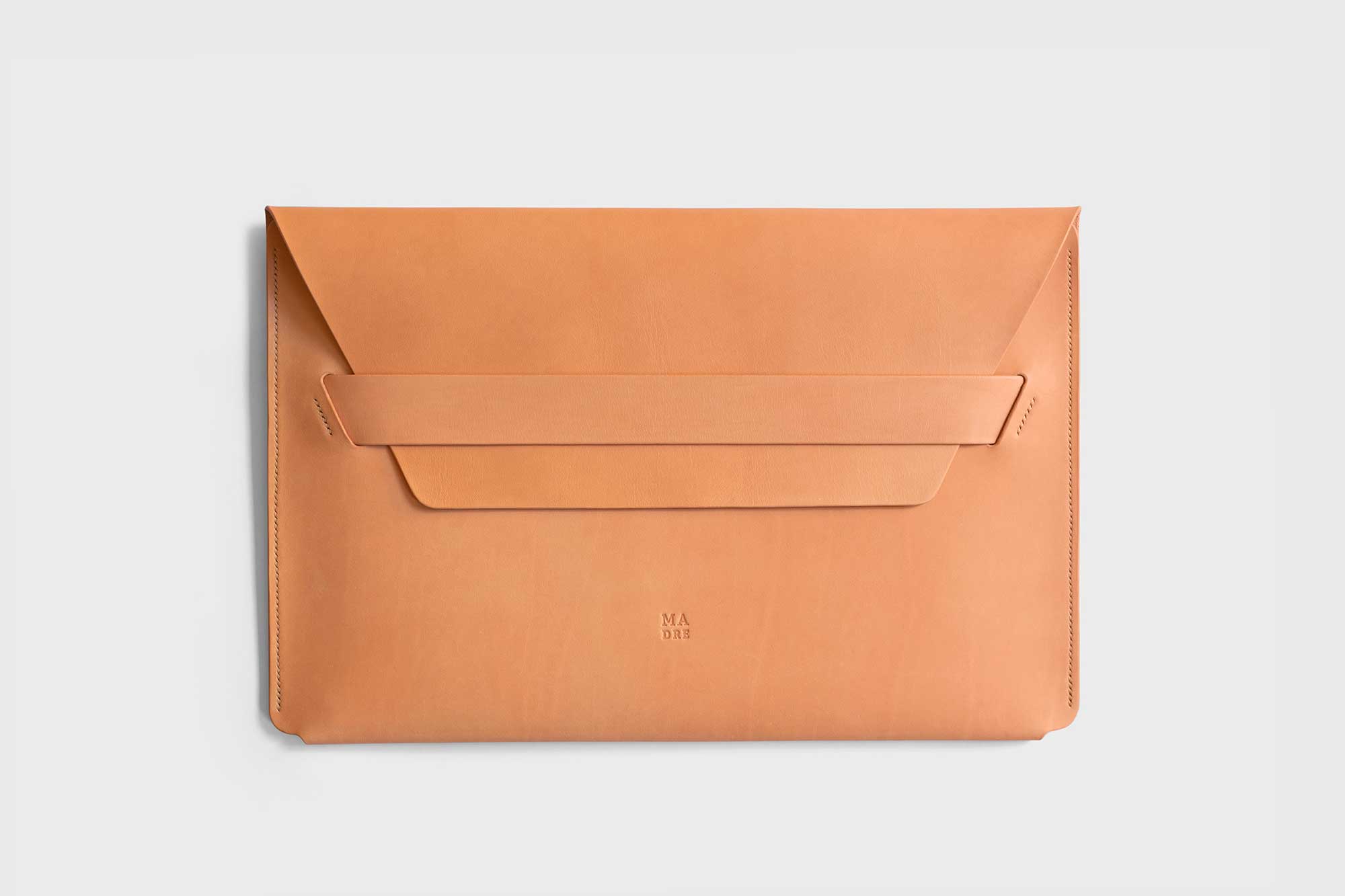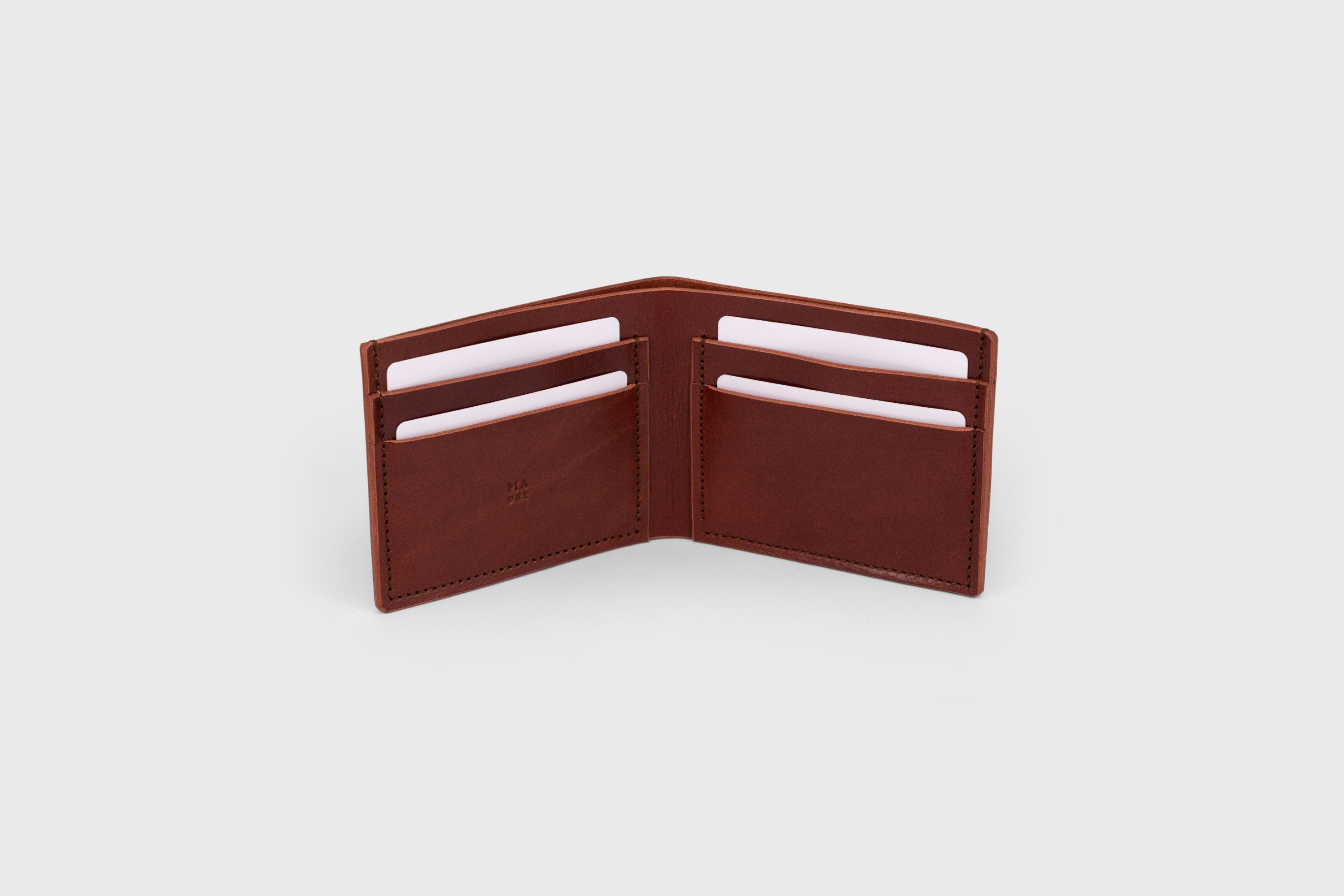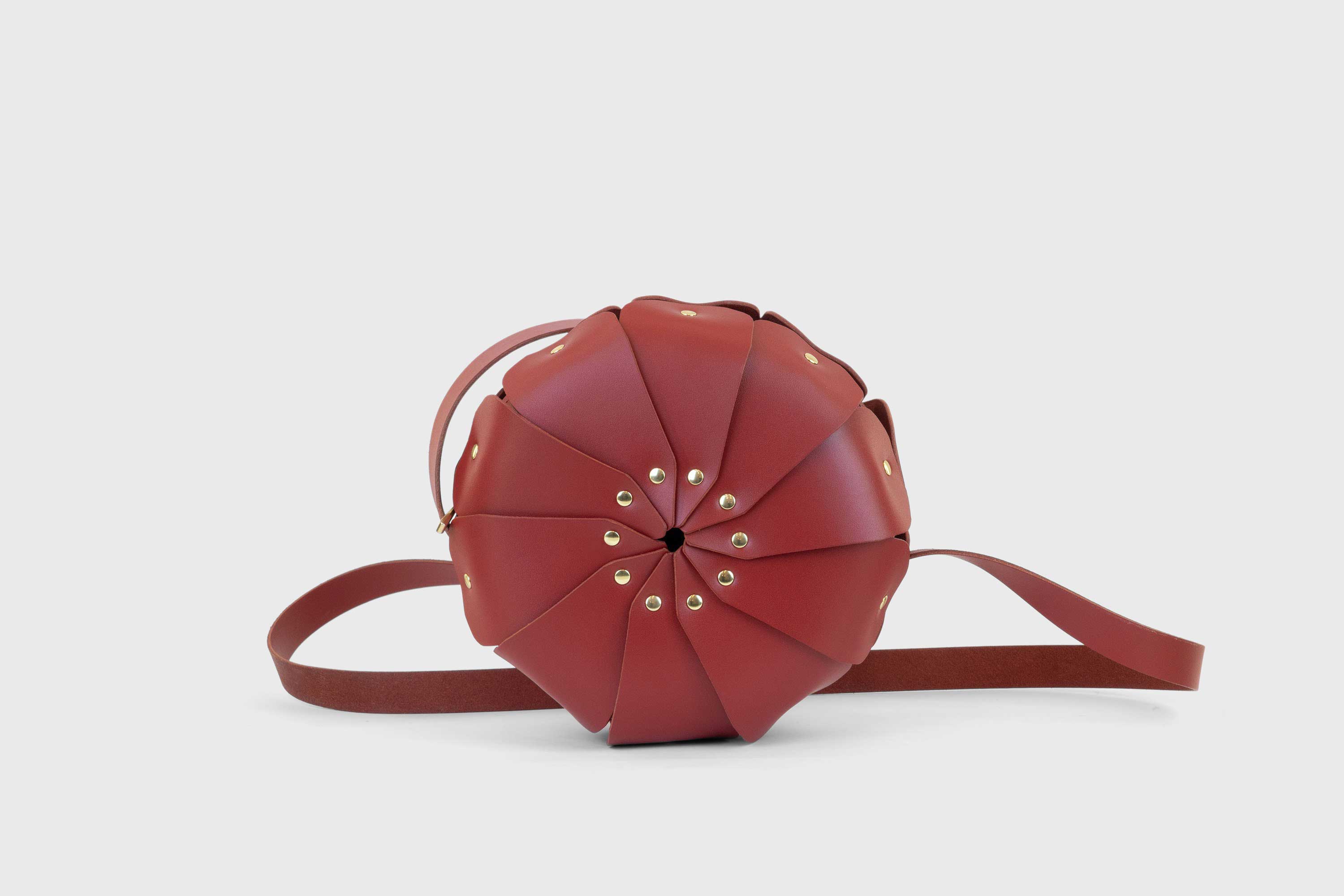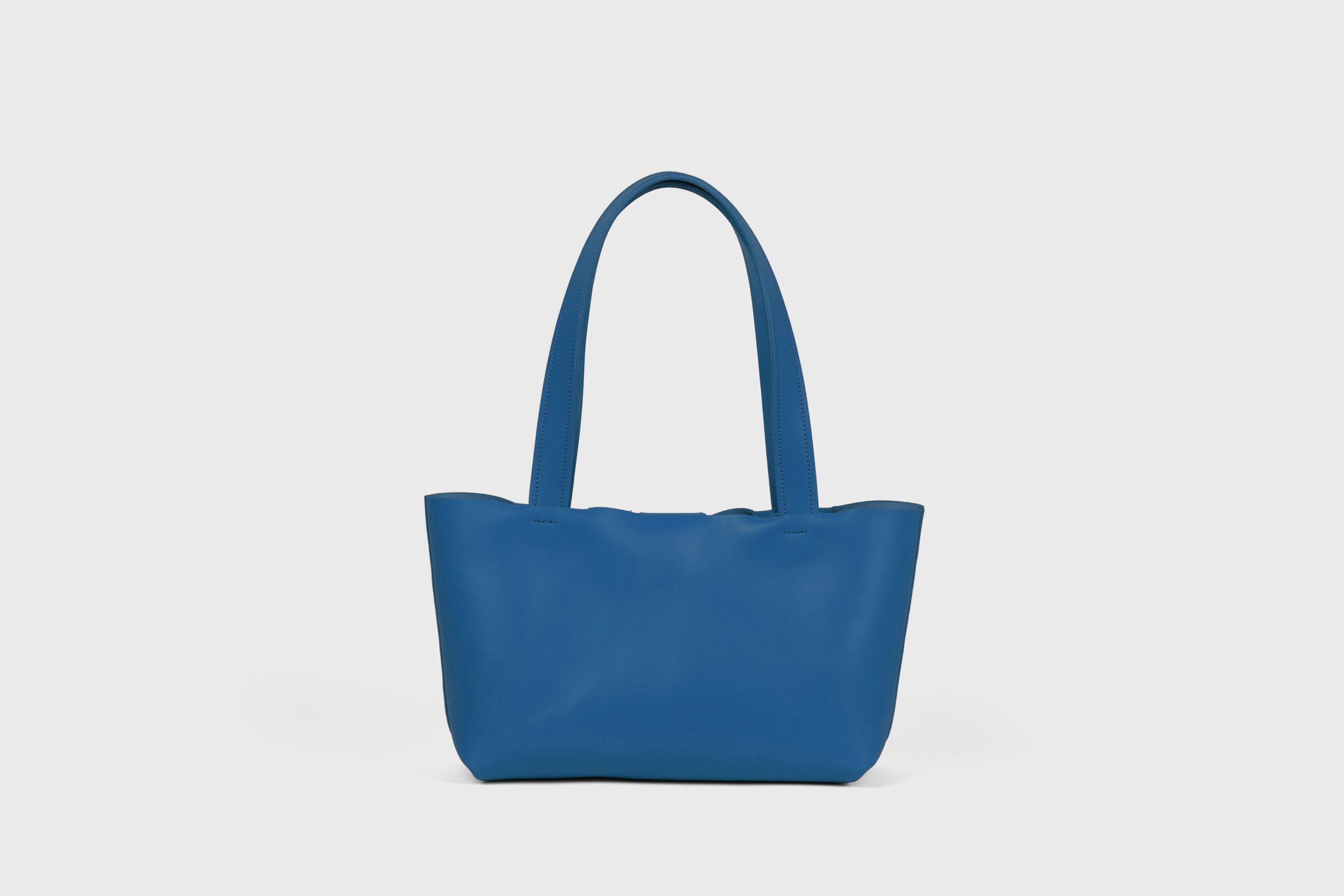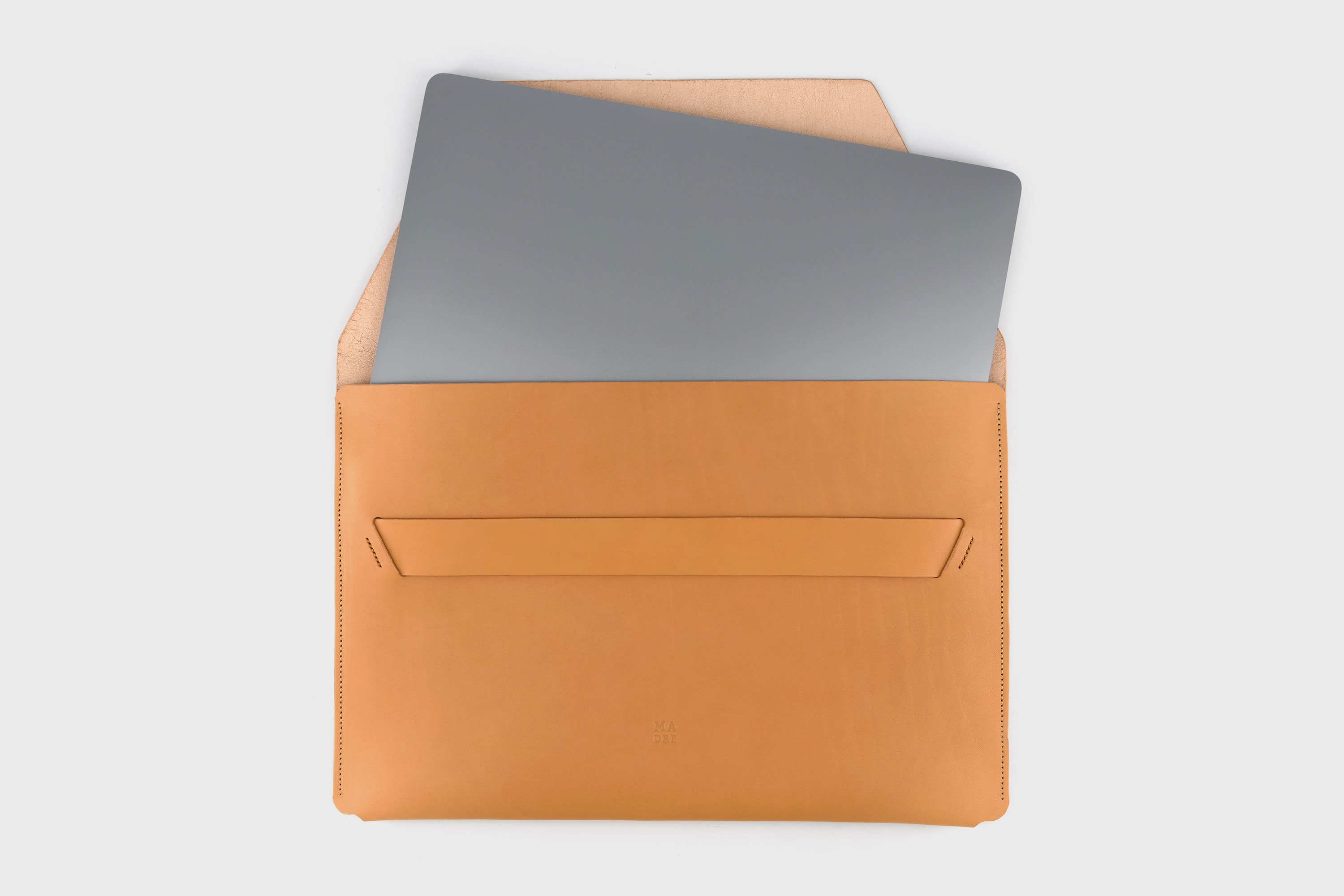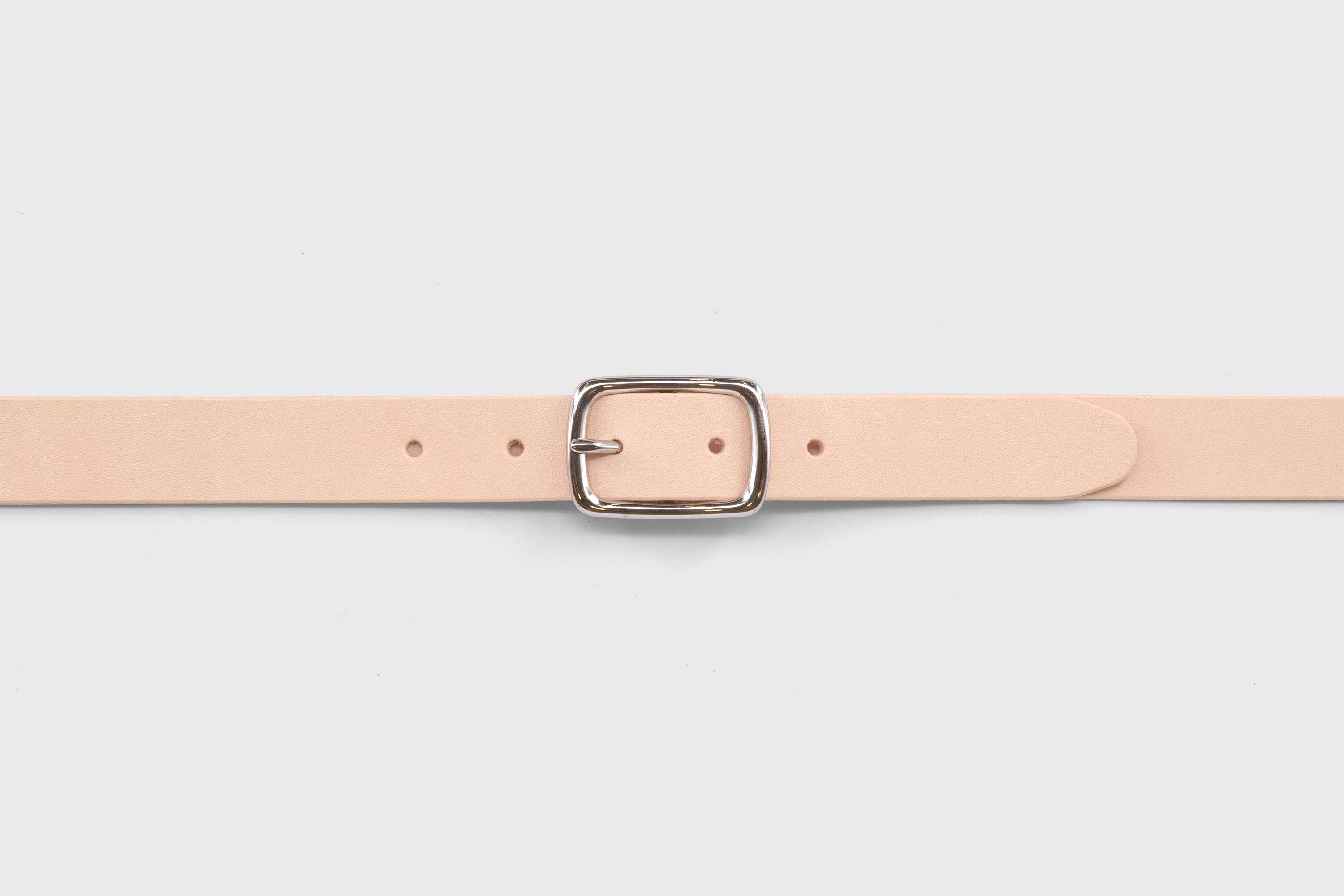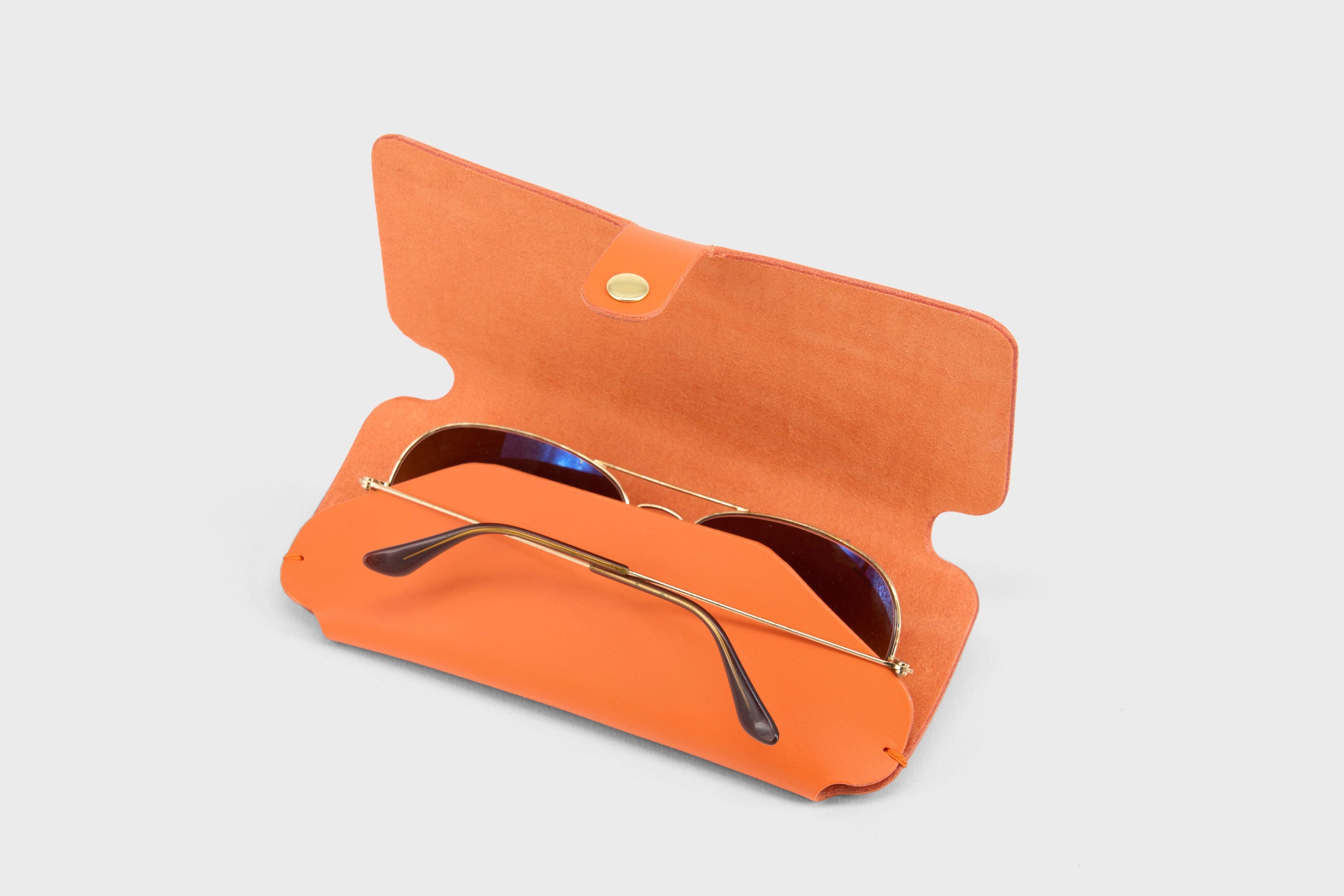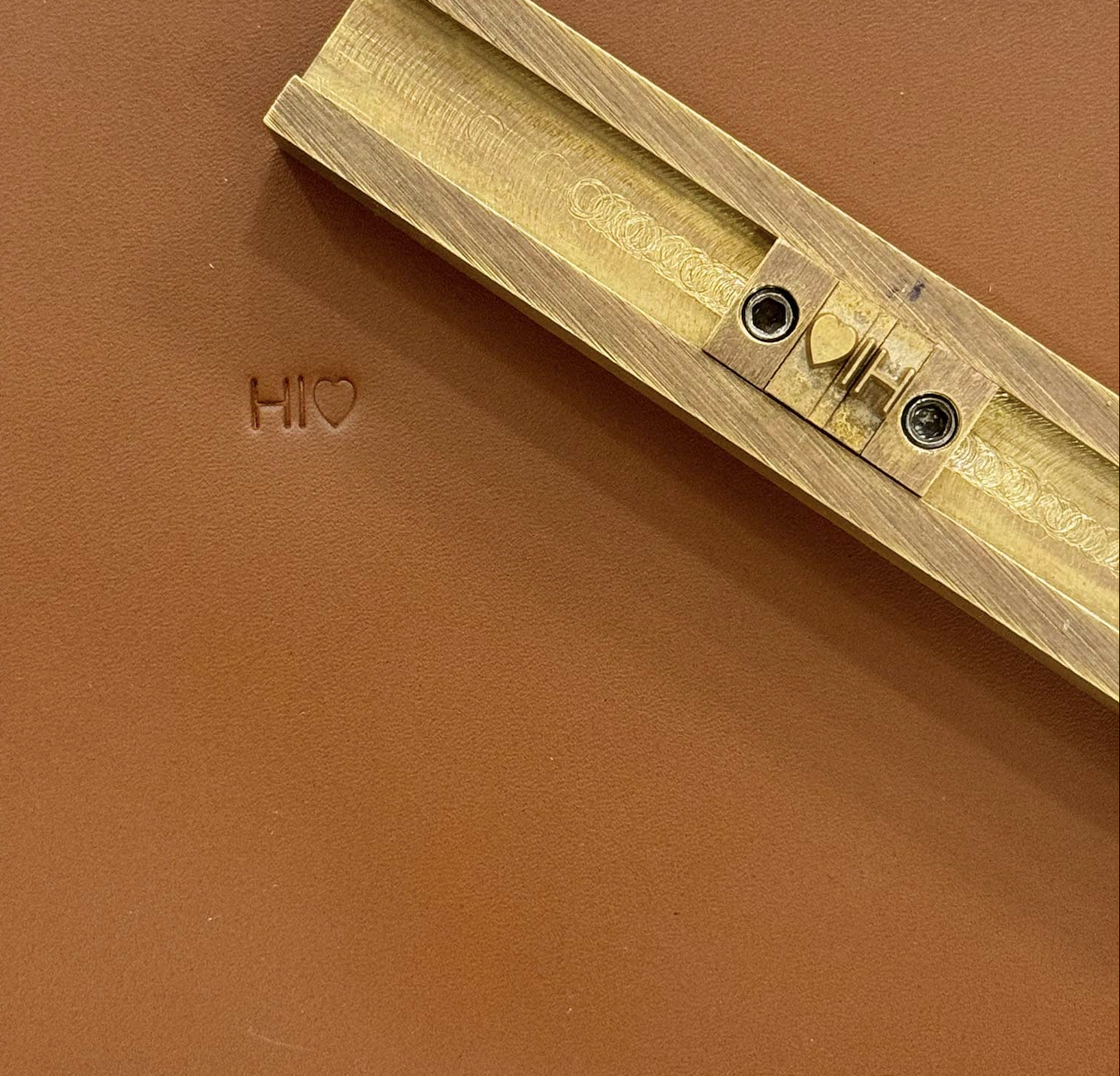The Basics of Leather and Where Oiled Leather Fits In
To truly appreciate the unique qualities of oiled leather, it’s important to understand where it stands in the broader category of leather types. Leather itself is a versatile, natural material that has been used for centuries due to its durability, flexibility, and aesthetic appeal. However, not all leather is created equal, and different treatments produce distinct types of leather, each with its own characteristics.
What is Leather?
Leather is a natural material made from the hides of animals, most commonly cows. The process of turning raw hides into usable leather is called tanning, and it determines the quality, durability, and texture of the final product. Depending on how the hide is processed, leather can fall into one of the following categories:
-
Full-Grain Leather:
Full-grain leather is the highest quality and most natural form of leather. The hide’s surface is left intact, retaining the natural grain and imperfections, which add to its character. It is durable, breathable, and develops a beautiful patina over time. -
Top-Grain Leather:
Top-grain leather is slightly processed to remove surface imperfections, resulting in a smoother and more uniform appearance. It is softer than full-grain leather but slightly less durable. -
Genuine Leather:
Genuine leather is made from the lower layers of the hide. It is more affordable but less durable compared to full-grain or top-grain leather. -
Bonded Leather:
Bonded leather is made by combining leather scraps with synthetic materials. It is the lowest quality leather and lacks the durability and feel of natural leather.
What Makes Oiled Leather Unique?
Oiled leather is a subcategory of full-grain or top-grain leather that has been treated with natural oils, greases, or waxes to enhance its durability, flexibility, and water resistance. Unlike smooth or polished leather, oiled leather has a matte finish with a slightly darker tone that highlights its natural grain and imperfections.
Here’s what sets oiled leather apart:
- The Oil Treatment: The process of saturating the leather with oils makes it softer, more pliable, and resistant to moisture.
- Unique Look and Feel: The rich, matte texture and deep color of oiled leather give it a rugged yet elegant appearance.
- Improved Durability: Thanks to the oil treatment, the leather becomes more resistant to scratches, scuffs, and wear.
- Aging Gracefully: Oiled leather develops a beautiful patina over time, showcasing its journey and enhancing its character.
How Oiled Leather Differs from Other Finishes
To better understand oiled leather, let’s compare it with other popular leather finishes:
| Leather Type | Appearance | Texture | Durability | Water Resistance |
|---|---|---|---|---|
| Oiled Leather | Matte, rich texture | Soft, pliable | High | Moderate to High |
| Smooth Leather | Polished, glossy finish | Firm, less pliable | High | Low to Moderate |
| Waxed Leather | Slight sheen, rugged | Soft, slightly firm | High | Moderate |
| Suede or Nubuck | Velvety, soft texture | Soft, delicate | Moderate | Low |
- Smooth Leather: Sleek and polished, but prone to scratches and less water-resistant.
- Waxed Leather: Similar to oiled leather but finished with wax for a slight sheen.
- Suede or Nubuck: Soft and luxurious but delicate and more susceptible to damage.
Oiled leather strikes the perfect balance between durability and flexibility, making it a go-to choice for rugged outdoor use, fashion accessories, and everyday products that require resilience and style.
The Origins of Oiled Leather

The use of oil to treat leather is not new. Historically, artisans and leatherworkers discovered that natural oils and greases could enhance the durability and flexibility of leather, especially in harsh conditions.
- Early Work Gear: In centuries past, farmers, cowboys, and tradesmen relied on oiled leather for boots, saddles, and tool belts. The oil treatment made these items resistant to moisture and wear, allowing them to withstand demanding environments.
- Military Use: Oiled leather gained prominence in military gear, where durability and weather resistance were essential. Soldiers wore boots and carried bags made of oiled leather for their toughness and comfort.
- Modern Innovations: Today, oiled leather continues to be popular for footwear, bags, furniture, and accessories. While the traditional process has remained largely the same, modern technology has improved the consistency and quality of oiled leather.
Why Oiled Leather Stands Out
Oiled leather is a favorite among artisans, designers, and consumers because it offers the best of both worlds: durability and natural beauty. Its rugged, earthy look appeals to those who appreciate classic craftsmanship, while its flexibility and resistance to damage make it practical for everyday use.
Whether it’s a pair of sturdy boots, a vintage satchel, or a timeless leather jacket, oiled leather pieces are designed to last—and look better with age.
How Oiled Leather is Made
The creation of oiled leather is a process that blends traditional craftsmanship with modern techniques. From selecting the right type of hide to the careful application of oils and greases, every step is essential to ensure the final product is durable, flexible, and visually appealing. Let’s take a closer look at how oiled leather is made.
1. Selecting the Right Leather
The foundation of any quality leather product lies in the raw material—the hide. Not all leather is suitable for oil treatment, so selecting the right leather is crucial.
-
Full-Grain Leather:
Full-grain leather, the highest quality, is often chosen for oiled leather. It retains the natural grain, giving the material character and strength. Full-grain leather is also breathable and ages beautifully over time. -
Top-Grain Leather:
Sometimes, top-grain leather is used for oiled treatments. It offers a smoother finish by removing some of the surface imperfections while maintaining strength and flexibility.
Why these types? Full-grain and top-grain leather absorb oils effectively, which enhances their durability and ensures the leather stays soft and supple for years. Lower-quality leather, such as bonded or genuine leather, lacks the structure and porosity needed to hold oil properly.
2. The Tanning Process
Before oiling the leather, the hides must go through a tanning process to prepare them. Tanning transforms raw hides into usable leather, making them durable, resistant to decay, and ready for finishing.
There are two main tanning methods used to produce oiled leather:
a) Vegetable Tanning
- What is it? A traditional and eco-friendly method where hides are treated with natural tannins extracted from tree bark, leaves, and fruits.
- Why it’s ideal for oiled leather: Vegetable-tanned leather has a porous structure that absorbs oils exceptionally well. It also develops a rich patina over time, enhancing the leather’s beauty as it ages.
- Benefits: Eco-friendly, durable, and biodegradable.
b) Chrome Tanning
- What is it? A faster, more industrialized process where chromium salts are used to tan the leather.
- Why it’s sometimes used: Chrome-tanned leather is softer and more pliable, making it suitable for applications requiring flexibility.
- Drawback: Less eco-friendly than vegetable tanning.
For premium oiled leather, vegetable-tanned hides are often preferred because of their natural finish, durability, and ability to age gracefully.
3. Applying the Oil Treatment
Once the leather is tanned, the magic of oiled leather begins. The leather is treated with oils, greases, or waxes to enhance its durability, flexibility, and water resistance.
Here’s how it works step by step:
Step 1: Preparing the Leather
The tanned leather is thoroughly cleaned and dried to ensure it’s free of any impurities. This allows the oils to penetrate evenly.
Step 2: Infusing the Oils
Natural oils, like neatsfoot oil, mink oil, or even plant-based oils, are applied to the leather surface. These oils are either:
- Hand-rubbed: Artisans manually rub oils into the leather using cloths or brushes to ensure even absorption.
- Machine-applied: In large-scale production, machines evenly coat the leather with oil for efficiency and consistency.
The oils penetrate the leather fibers, softening the material and forming a protective barrier that increases water resistance.
Step 3: Heat Treatment (Optional)
In some cases, the oiled leather is gently heated to help the oils soak deeper into the fibers. This ensures that the leather remains soft and pliable while enhancing its resistance to moisture and wear.
Step 4: Adding Finishing Touches
Once the oil treatment is complete, the leather may be buffed or polished to achieve the desired texture and look. Some oiled leather is left matte and rugged, while others receive light wax coatings for added sheen.
4. Common Oils Used in Oiled Leather
The type of oil used during the treatment plays a significant role in determining the final quality of the leather. Here are some commonly used oils:
- Neatsfoot Oil: Derived from cattle bones and hooves, neatsfoot oil is a traditional choice for softening and conditioning leather.
- Mink Oil: Known for its water-repelling properties, mink oil is excellent for protecting leather against moisture.
- Vegetable Oils: Plant-based oils like linseed oil are sometimes used for eco-friendly leather treatments.
- Beeswax and Greases: Occasionally, a blend of wax and oil is applied to enhance durability and provide additional protection.
Each oil penetrates the leather fibers differently, so the choice of oil depends on the intended use and desired look of the final product.
5. Quality Control and Inspection
Before oiled leather is ready for use, it undergoes rigorous quality checks to ensure consistency, durability, and appearance. Artisans inspect the leather for:
- Even oil penetration.
- Absence of cracks, blemishes, or uneven textures.
- Flexibility and water resistance.
Once approved, the oiled leather is ready to be used for crafting products like boots, bags, belts, and furniture.
Why the Oiling Process Matters
The oiling process isn’t just about aesthetics—it’s about creating a leather that can withstand the test of time. By infusing the hide with oils, the leather gains:
- Enhanced Flexibility: The fibers remain soft and pliable, preventing cracks or stiffness.
- Water Resistance: Oils form a natural barrier that repels moisture, making oiled leather ideal for outdoor and rugged use.
- Improved Durability: The oils strengthen the leather, allowing it to resist wear, tear, and scuffs better than untreated leather.
- A Natural Look: The oil treatment accentuates the natural grain and imperfections of the hide, giving the leather a unique, rustic charm.
Characteristics of Oiled Leather
Oiled leather stands out in the vast world of leather for its rugged beauty, durability, and flexibility. The careful oiling process gives it properties that make it ideal for both functional and aesthetic purposes. Whether you're using it for boots, bags, or furniture, oiled leather brings a unique combination of strength and style. Let’s explore the defining characteristics that make oiled leather so exceptional.
1. Exceptional Durability
One of the most celebrated features of oiled leather is its durability. Thanks to the oil treatment, the leather’s natural fibers are strengthened and reinforced, allowing it to withstand wear and tear better than untreated leather.
- Resistant to Cracks and Breaks: The oils keep the leather fibers soft and pliable, preventing them from drying out or cracking over time.
- Built for Heavy Use: Whether it’s hiking boots trudging through mud or a tool belt enduring daily strain, oiled leather is designed for rugged, demanding conditions.
- Long-Lasting Quality: With proper care, oiled leather products can last for decades, making them a worthwhile investment.
2. Water and Weather Resistance
Oiled leather’s ability to repel moisture is one of its most practical benefits. The oils infused into the leather create a natural barrier that resists water, rain, and snow.
- Why it Works: The oil fills the pores of the leather, reducing its ability to absorb water. Instead of soaking into the fibers, water beads on the surface and rolls off.
- Perfect for Outdoor Gear: Oiled leather is commonly used for hiking boots, saddles, and tool belts because it can endure wet conditions without becoming damaged.
- Important Note: While oiled leather is water-resistant, it’s not fully waterproof. Prolonged exposure to water can still lead to stains or drying, so it’s essential to care for it properly.
3. Unique Texture and Appearance
Oiled leather has a distinct look and feel that sets it apart from other types of leather.
- Matte Finish: Unlike polished leather, oiled leather has a matte, rugged finish that highlights its natural grain and imperfections. This gives it a more casual and earthy appearance.
- Soft and Supple Texture: The oil treatment makes the leather softer and more flexible, making it comfortable to use right away—no breaking-in period needed.
- Aged Beauty: Over time, oiled leather develops a rich patina that enhances its character. Scratches and scuffs often blend in with the leather’s texture, adding to its charm rather than detracting from its beauty.
Pro Tip: If you scratch an oiled leather product, rubbing the area lightly with your fingers can often blend the mark into the surrounding leather. The oils help scratches fade naturally over time.
4. Flexibility and Comfort
Oiled leather is not just durable; it’s also remarkably flexible. Unlike stiff, untreated leather that takes time to soften, oiled leather is ready for use right away.
- Softness from Day One: The oils keep the fibers supple, allowing the leather to bend and move without losing its shape.
- Perfect for Footwear and Accessories: Whether it’s boots, belts, or gloves, oiled leather provides immediate comfort while still maintaining its structure.
- Reduced Break-In Time: Shoes or boots made from oiled leather require less time to conform to your feet, making them more comfortable for extended wear.
5. Natural Aging and Patina Development
One of the most beautiful characteristics of oiled leather is its ability to age gracefully.
- What is Patina? Patina refers to the unique sheen or coloration that develops on leather over time as it’s exposed to oils, sunlight, and regular use.
- Why it Matters: Instead of looking worn out, oiled leather products become richer and more visually appealing with age.
- Personalization Through Wear: Every mark, crease, or scratch adds to the leather’s story, creating a piece that feels uniquely yours.
For example:
- A well-loved oiled leather bag might develop subtle dark spots where the leather has absorbed oils from your hands.
- Boots that have seen years of wear will show scuffs and creases, which only add to their character.
6. Breathability
Despite its water-resistant properties, oiled leather remains naturally breathable. The oil treatment fills the pores without completely sealing them, allowing air to pass through the material.
- Comfortable Footwear: Boots and shoes made from oiled leather regulate moisture and temperature, keeping your feet comfortable for long periods.
- Reduces Moisture Build-Up: Breathable leather prevents excessive sweating or dampness, which can lead to odors or discomfort.
7. Scratch and Scuff Resistance
Oiled leather has a rugged resilience that makes it more forgiving when it comes to scratches and scuffs.
- Self-Healing Quality: Minor scratches can often be "buffed out" simply by rubbing the leather or applying a small amount of oil.
- Perfect for Everyday Use: Bags, belts, and wallets made from oiled leather hold up well under daily wear and tear, making them ideal for long-term use.
Why These Characteristics Matter
The combination of durability, water resistance, and unique aesthetics makes oiled leather one of the most versatile materials available. Whether you’re trekking through rugged terrain, commuting to work, or carrying a timeless leather bag, oiled leather offers:
- Functionality: It’s tough enough to endure heavy use without falling apart.
- Beauty: Its matte finish and natural grain create a sophisticated yet rugged look.
- Longevity: With proper care, oiled leather only gets better with age, developing a patina that makes it a true investment piece.
These characteristics make oiled leather a favorite for outdoor enthusiasts, artisans, and fashion lovers alike. It’s no surprise that this material is used for everything from boots and jackets to tool belts, saddles, and furniture.
Common Uses for Oiled Leather
Thanks to its exceptional durability, flexibility, and water-resistant qualities, oiled leather is a favorite material for a wide range of products. Its rugged appeal and ability to withstand daily wear make it particularly suitable for items that need to last for years while maintaining their character. From outdoor gear to stylish accessories, oiled leather strikes the perfect balance between functionality and beauty.

Let’s explore some of the most popular and practical uses of oiled leather across industries and lifestyles.
1. Footwear
Oiled leather is a top choice for footwear, especially for boots and shoes that are subjected to tough conditions.
- Work Boots: Construction workers, farmers, and tradespeople rely on oiled leather boots for their rugged durability and water resistance. The soft, flexible nature of the material ensures comfort during long hours of wear.
- Hiking Boots: Oiled leather is ideal for hiking and outdoor boots because it can handle rough terrain, mud, and moisture without wearing down. The material’s natural breathability also keeps feet dry and comfortable.
- Casual Footwear: Shoes, loafers, and sandals made from oiled leather combine a laid-back aesthetic with unmatched longevity. They’re perfect for everyday wear.
Why it Works: Oiled leather boots and shoes are ready to go right out of the box—no long break-in period. They also resist scratches and scuffs, making them ideal for rugged use.
2. Bags and Accessories
Oiled leather’s durability and timeless look make it perfect for crafting premium leather bags and accessories.
- Messenger Bags and Satchels: These everyday essentials benefit from oiled leather’s rugged charm and ability to handle heavy use. Whether you’re commuting to work or traveling, an oiled leather bag looks stylish and ages beautifully.
- Backpacks and Travel Bags: Designed for durability, oiled leather backpacks and duffle bags can endure the demands of travel while keeping your belongings safe and dry.
- Wallets and Cardholders: Oiled leather wallets are soft, flexible, and resistant to wear. They develop a rich patina with time, adding a unique character that reflects their use.
- Belts: Oiled leather belts are sturdy and reliable, holding up against daily strain without stretching or breaking. Their rugged, matte finish complements casual and formal outfits alike.
Why it Works: Bags and accessories made from oiled leather are practical, stylish, and long-lasting. They’re perfect for anyone looking to invest in timeless pieces that get better with age.
3. Furniture and Upholstery
Oiled leather is a popular choice for furniture and upholstery because of its durability and ability to withstand heavy use.
- Sofas and Armchairs: Leather furniture crafted from oiled leather has a rich, natural look that adds warmth and sophistication to any space. Its resistance to scuffs and scratches makes it ideal for families and homes with pets.
- Dining Chairs: Upholstered dining chairs benefit from oiled leather’s easy-to-clean surface and resilience. Spills and stains can be wiped off without leaving marks.
- Office Chairs: Oiled leather office chairs combine comfort, durability, and elegance, creating a professional yet inviting workspace.
Why it Works: Oiled leather furniture requires minimal maintenance and ages beautifully. Over time, it develops a patina that enhances its appearance, making it a timeless addition to any home or office.
4. Outdoor Gear and Equipment
Oiled leather has a long history of being used in outdoor gear, where durability and water resistance are essential.
- Saddles and Equestrian Equipment: Oiled leather saddles, reins, and bridles are prized for their ability to handle moisture, dirt, and constant movement while remaining soft and flexible.
- Tool Belts and Holsters: Tradespeople use oiled leather tool belts and holsters because they can carry heavy tools without tearing or wearing out.
- Gloves and Protective Gear: Oiled leather gloves provide excellent protection for workers, gardeners, and riders, as they’re resistant to abrasions while remaining comfortable to wear.
- Camping Gear: From tent straps to knife sheaths, oiled leather is a reliable material for outdoor enthusiasts who need gear that can endure the elements.
Why it Works: Oiled leather is water-resistant, tough, and flexible, making it the perfect choice for gear that needs to withstand harsh weather and heavy use.
5. Automotive Interiors
Luxury car manufacturers often use oiled leather for upholstery, steering wheels, and gear shift covers. Its durability and rich texture make it a preferred choice for premium interiors.
- Seats and Upholstery: Oiled leather car seats are resistant to wear and tear while offering a luxurious, matte finish that enhances the car’s aesthetics.
- Steering Wheel Covers: Leather steering wheels provide a comfortable grip and look stylish, especially when crafted from oiled leather.
Why it Works: Oiled leather car interiors combine durability, comfort, and sophistication, elevating the overall driving experience.
6. Jackets and Clothing
Leather clothing, especially jackets, benefits greatly from the soft, flexible properties of oiled leather.
- Leather Jackets: Oiled leather jackets have a rugged, worn-in look that makes them a timeless fashion staple. They’re comfortable to wear right away and become softer with time.
- Aprons: Artisans, blacksmiths, and chefs often wear oiled leather aprons because they provide protection from heat, sparks, and spills.
- Gloves: Oiled leather gloves are ideal for both fashion and function, offering a balance of comfort, warmth, and durability.
Why it Works: Oiled leather clothing is stylish, practical, and durable. It adapts to your movements and becomes more comfortable the longer you wear it.
Why Oiled Leather is Perfect for Everyday Use
The versatility of oiled leather makes it suitable for a wide range of applications. Whether you’re looking for footwear that can handle rough terrain, a bag that will last a lifetime, or furniture that combines elegance with durability, oiled leather delivers.
Here’s why it’s perfect for everyday use:
- Tough Yet Flexible: It can endure heavy use while staying soft and comfortable.
- Water Resistance: It repels moisture, making it ideal for outdoor and rugged environments.
- Aging Gracefully: Oiled leather develops a beautiful patina that enhances its character over time.
- Low Maintenance: With minimal care, oiled leather products can last for decades, making them a wise investment.
Advantages and Disadvantages of Oiled Leather
Oiled leather is loved for its durability, rugged beauty, and flexibility, making it a popular choice for products that need to stand the test of time. However, like any material, it has both its strengths and limitations. Understanding these advantages and disadvantages will help you decide whether oiled leather is the right choice for your needs, whether you're buying boots, bags, or home furnishings.
Advantages of Oiled Leather
1. Exceptional Durability
Oiled leather is renowned for its ability to withstand years of wear and tear. The infusion of oils reinforces the leather fibers, making them resistant to cracking, splitting, or hardening over time.
- Perfect for Everyday Use: Whether it’s a bag that carries your daily essentials, boots that handle tough terrain, or furniture subjected to regular use, oiled leather can handle it all.
- Resilient Under Stress: It remains strong under tension and doesn’t tear or stretch easily, making it ideal for rugged applications like work gear and outdoor products.
2. Water Resistance
One of oiled leather’s most significant benefits is its natural water-repelling properties. The oil treatment fills the pores of the leather, preventing water from being absorbed into the material.
- Protection from Rain and Moisture: Oiled leather is the material of choice for boots, bags, and saddles that are often exposed to wet conditions.
- Minimizes Damage: Water droplets bead up and roll off the leather’s surface instead of soaking in, reducing the risk of stains or damage.
Note: While water-resistant, oiled leather is not waterproof. Prolonged exposure to moisture can still cause issues if the leather isn’t cared for properly.
3. Flexibility and Comfort
Unlike some types of leather that can feel stiff initially, oiled leather is soft, flexible, and comfortable from day one. This pliability makes it ideal for items that require movement, such as footwear, gloves, and bags.
- Quick Break-In Period: Oiled leather boots and shoes adapt to your feet faster, providing comfort with minimal effort.
- Maintains Its Shape: Despite being flexible, oiled leather doesn’t lose its structure, ensuring that products retain their form even after years of use.
4. Natural Beauty and Patina
Oiled leather has a rugged, matte finish that showcases the material’s natural grain. Over time, it develops a beautiful patina—a soft sheen and deeper color that reflect the leather’s age and use.
- Unique Aging Process: Scratches, scuffs, and daily wear blend into the leather’s surface, enhancing its character rather than diminishing its appeal.
- Timeless Aesthetic: Whether you’re carrying an oiled leather bag or wearing a jacket, the material’s rich texture and understated elegance never go out of style.
5. Low Maintenance
Compared to other types of leather, oiled leather is relatively easy to maintain. The oils applied during treatment reduce the need for frequent conditioning and keep the leather looking fresh and healthy.
- Minor Scratches Disappear: Light scratches or scuffs can often be blended in with a simple rub of your finger.
- Self-Healing Quality: The oil naturally nourishes the leather, preventing excessive drying or damage.
6. Versatility
Oiled leather’s combination of toughness and beauty makes it suitable for a wide range of products, including:
- Boots and shoes.
- Bags, belts, and wallets.
- Furniture and upholstery.
- Outdoor equipment and saddlery.
It adapts well to both rugged, utilitarian applications and stylish, everyday accessories.
7. Sustainability
When produced using vegetable tanning and natural oils, oiled leather is an eco-friendly alternative to chemically treated leathers.
- Biodegradable: Vegetable-tanned oiled leather breaks down naturally over time.
- Reduced Chemical Use: Natural oils like beeswax, neatsfoot oil, and plant-based oils minimize environmental impact.
Disadvantages of Oiled Leather
While oiled leather has many advantages, it’s not without its limitations. Here are some factors to consider:
1. Heavier Weight
The oil treatment adds density to the leather, making it slightly heavier than other types of leather.
- Impact on Footwear: Oiled leather boots, for example, can feel heavier on the feet compared to lighter materials like nubuck or suede.
- Larger Bags and Accessories: Duffle bags, backpacks, or briefcases made of oiled leather can feel substantial, which might not appeal to everyone.
2. Limited Breathability
While oiled leather is water-resistant, the oil treatment reduces the material’s natural breathability to some extent.
- Effect on Footwear: In hot climates, oiled leather boots or shoes may retain heat, making them less comfortable for prolonged use.
- Not Ideal for Humid Conditions: Reduced breathability can sometimes lead to moisture build-up, especially in products like gloves or jackets.
3. Darkening and Staining
Oiled leather is prone to changes in color when exposed to moisture, oils, or heavy use.
- Dark Spots: Water droplets or contact with oily hands can cause darker patches on the leather’s surface.
- Absorbs Oils Easily: Oiled leather may stain if it comes into contact with grease, lotions, or other oily substances.
Solution: Regular cleaning and conditioning can help even out discoloration and restore the leather’s appearance.
4. Requires Occasional Re-Oiling
While oiled leather is low maintenance compared to untreated leather, it still requires periodic care to keep it in top condition.
- When to Re-Oil: Over time, the oils in the leather can dry out, especially if the product is exposed to sunlight or harsh weather. Reapplying oil or conditioner will help restore its softness and protective barrier.
- Takes Effort: Conditioning and cleaning require time and care to ensure the leather remains healthy.
5. Higher Cost
Oiled leather is often more expensive than other types of leather because of the quality of the material and the labor-intensive treatment process.
- Investment Piece: While the initial cost may be higher, oiled leather products offer long-term value due to their durability and longevity.
Is Oiled Leather Worth It?
For anyone who values quality, durability, and timeless style, oiled leather is absolutely worth the investment. While it does come with some weight and maintenance considerations, the benefits far outweigh the drawbacks:
- It lasts for decades when cared for properly.
- Its water-resistant properties make it ideal for outdoor and rugged use.
- It develops a unique patina that adds character and individuality over time.
- It requires minimal effort to maintain compared to untreated leather.
If you’re looking for a product that combines functionality with beauty—whether it’s a pair of boots, a satchel, or a piece of furniture—oiled leather is an exceptional choice that only gets better with age.
Oiled Leather vs. Other Leather Types
Oiled leather is often compared to other types of leather due to its unique properties, rugged appeal, and durability. However, understanding how it differs from other leather varieties—like waxed leather, smooth leather, suede, and nubuck—can help you make more informed decisions when choosing the right material for your needs.
In this section, we’ll break down the key differences between oiled leather and other popular leather types, focusing on appearance, durability, maintenance, and use cases.
1. Oiled Leather vs. Waxed Leather
At first glance, oiled leather and waxed leather can appear quite similar because both are treated to enhance durability and resistance to moisture. However, the two materials differ in their finish and texture.
| Feature | Oiled Leather | Waxed Leather |
|---|---|---|
| Finish | Matte, rich texture with natural grain | Slight sheen due to wax application |
| Feel | Soft, supple, and pliable | Firmer texture with a slightly slick feel |
| Water Resistance | Highly water-resistant, absorbs less water | Water-resistant, but wax may wear off |
| Aging | Develops a rich patina with time | Wax layer may need refreshing regularly |
| Maintenance | Requires occasional oil reapplication | Requires rewaxing to maintain protection |
| Common Uses | Boots, bags, saddles, furniture | Jackets, bags, boots, and accessories |
Key Takeaway: Oiled leather is softer, more pliable, and has a matte finish, while waxed leather has a firmer structure and a subtle sheen due to the wax layer. Both materials are durable, but waxed leather may require more frequent maintenance to maintain its protective coating.
2. Oiled Leather vs. Smooth Leather
Smooth leather refers to untreated or lightly treated leather with a sleek, polished surface. While smooth leather is elegant and refined, it’s less rugged and more prone to scratches than oiled leather.
| Feature | Oiled Leather | Smooth Leather |
|---|---|---|
| Finish | Matte with visible natural grain | Smooth, glossy, polished surface |
| Durability | Very durable and scratch-resistant | Durable but more prone to scratches |
| Water Resistance | Water-resistant due to oil treatment | Low water resistance; absorbs moisture |
| Flexibility | Soft and flexible | Stiffer, especially when new |
| Aging | Develops a rugged, character-rich patina | Maintains a polished look with care |
| Common Uses | Outdoor gear, rugged boots, bags | Dress shoes, formal bags, accessories |
Key Takeaway: Oiled leather is better suited for rugged, outdoor use due to its water resistance and flexibility, while smooth leather excels in formal or polished settings. Smooth leather requires more care to maintain its pristine look.
3. Oiled Leather vs. Suede
Suede is a soft, velvety material made from the underside of animal hides. While suede is luxurious and fashionable, it is far less durable and water-resistant than oiled leather.
| Feature | Oiled Leather | Suede |
|---|---|---|
| Finish | Matte with natural grain | Soft, velvety, and fuzzy surface |
| Durability | Extremely durable, resistant to wear | Delicate and prone to damage |
| Water Resistance | Water-resistant | Low water resistance; stains easily |
| Flexibility | Soft and pliable | Soft but not as structurally strong |
| Maintenance | Low maintenance; occasional oiling | Requires special brushes and protectants |
| Common Uses | Boots, bags, outdoor gear | Fashion shoes, jackets, and accessories |
Key Takeaway: Suede is perfect for fashion-forward, lightweight items but is highly susceptible to moisture and wear. In contrast, oiled leather is far more durable, weather-resistant, and suited for rugged or everyday use.
4. Oiled Leather vs. Nubuck Leather
Nubuck leather is similar to suede but is made from the top grain of the hide. It has a slightly rough, velvety texture and is more durable than suede but still less resilient compared to oiled leather.
| Feature | Oiled Leather | Nubuck Leather |
|---|---|---|
| Finish | Matte with visible grain | Velvety texture with a fine nap |
| Durability | Highly durable, scratch-resistant | Durable but can scuff easily |
| Water Resistance | Naturally water-resistant | Requires waterproof sprays |
| Flexibility | Soft, pliable, and adaptable | Soft but more delicate than oiled leather |
| Maintenance | Requires occasional oiling | Requires special care to prevent stains |
| Common Uses | Outdoor boots, bags, saddlery | Fashion shoes, casual bags, and jackets |
Key Takeaway: While nubuck has a luxurious, velvety texture, it’s more susceptible to scuffing and moisture damage compared to oiled leather. Oiled leather offers better durability and is better suited for functional, outdoor products.
5. Oiled Leather vs. Full-Grain Leather
Full-grain leather is often considered the gold standard of leather due to its durability and natural beauty. Interestingly, oiled leather often is full-grain leather that has undergone oil treatment.
| Feature | Oiled Leather | Full-Grain Leather |
|---|---|---|
| Finish | Matte with enhanced natural grain | Natural grain with no added treatments |
| Durability | Extremely durable and water-resistant | Extremely durable; ages beautifully |
| Water Resistance | Enhanced water resistance from oiling | Low to moderate water resistance |
| Maintenance | Low maintenance; occasional oiling | Requires regular conditioning |
| Flexibility | Soft, pliable, and ready to use | Stiffer initially; softens with use |
| Common Uses | Outdoor boots, bags, furniture | Luxury bags, shoes, belts, and furniture |
Key Takeaway: Oiled leather is often treated full-grain leather. While both are extremely durable and long-lasting, oiled leather has the added benefit of water resistance and a softer, ready-to-use feel.
Summary: Why Oiled Leather Stands Out
When compared to other types of leather, oiled leather holds a unique position thanks to its:
- Unmatched Durability: Tough enough for rugged use and long-term wear.
- Natural Water Resistance: A feature lacking in untreated smooth, suede, or nubuck leather.
- Low Maintenance: Minor scratches and marks blend in, and occasional oiling keeps the material healthy.
- Beautiful Aging: Develops a unique patina that tells its story over time.
Oiled leather combines the best of both worlds: the toughness of full-grain leather with enhanced softness and weather resistance. It’s an excellent choice for those who want leather products that are functional, stylish, and built to last.
How to Care for Oiled Leather
Oiled leather is prized for its durability, water resistance, and rugged aesthetic, but like all leather, it requires regular care to maintain its quality and appearance. Proper care ensures that your oiled leather items—whether boots, bags, furniture, or accessories—stay soft, flexible, and beautiful for years to come. Fortunately, oiled leather is low-maintenance compared to other types of leather, making it an excellent choice for practical, everyday use.
In this section, we’ll walk through the step-by-step process of cleaning, conditioning, and storing oiled leather. We’ll also cover common mistakes to avoid and tips for restoring older or damaged pieces.
1. Cleaning Oiled Leather
Regular cleaning is essential to remove dirt, dust, and grime from the surface of your oiled leather products. Here’s how to clean oiled leather properly:
Step 1: Remove Surface Dust and Dirt
- Use a soft, dry cloth or a horsehair brush to gently wipe off dust and debris from the surface.
- For crevices and stitching, use a small, soft-bristled brush to ensure no dirt is trapped.
Step 2: Wipe with a Damp Cloth
- If your leather is lightly soiled, dampen a clean cloth with lukewarm water (not soaking wet).
- Gently wipe the surface of the leather to lift any dirt. Avoid applying excessive moisture.
Step 3: Use a Leather Cleaner for Stubborn Stains
- For tougher stains, apply a pH-balanced leather cleaner sparingly to a clean cloth.
- Test the cleaner on a small, hidden area first to ensure it doesn’t cause discoloration.
- Gently rub the cleaner into the stained area in circular motions. Avoid scrubbing too hard, as this can damage the leather’s surface.
Step 4: Dry the Leather
- Allow the leather to air-dry naturally in a cool, well-ventilated area.
- Avoid heat sources like hairdryers, radiators, or direct sunlight, as they can dry out and crack the leather.
2. Conditioning Oiled Leather
Over time, the natural oils in oiled leather can dry out, especially if the product is exposed to harsh weather, sunlight, or heavy use. Conditioning replenishes these oils, keeping the leather soft, pliable, and protected.
When to Condition
- Condition your oiled leather every 3–6 months, depending on use.
- If the leather feels dry, stiff, or shows signs of cracking, it’s time to condition.
How to Condition Oiled Leather
-
Choose the Right Product:
- Use a high-quality leather conditioner or natural oil like mink oil, neatsfoot oil, or beeswax-based products.
- Avoid silicone-based products, as they can seal the pores of the leather and reduce its breathability.
-
Clean the Leather First:
- Always clean the leather before conditioning to remove any dirt or dust. Applying conditioner to dirty leather can trap grime in the material.
-
Apply Conditioner Sparingly:
- Use a soft, lint-free cloth to apply a small amount of conditioner or oil to the leather’s surface.
- Rub the conditioner into the leather in circular motions, ensuring even coverage.
-
Allow the Leather to Absorb:
- Let the leather sit for a few hours (or overnight) to allow the conditioner to penetrate fully.
-
Buff the Surface:
- Use a clean, dry cloth to buff off any excess conditioner. This will leave the leather looking smooth and even.
3. Waterproofing Oiled Leather
While oiled leather is naturally water-resistant, regular exposure to moisture can wear down its protective barrier. Adding a waterproofing treatment helps protect your leather products in wet conditions.
- Waterproofing Sprays: Use a leather-friendly waterproofing spray designed for oiled leather. Apply it evenly to the surface, holding the can 6–8 inches away. Allow it to dry naturally.
- Beeswax Treatments: Beeswax-based waterproofing products provide excellent protection and can be buffed into the leather for added shine.
Tip: Reapply waterproofing treatments every few months if the leather is frequently exposed to rain or snow.
4. Storing Oiled Leather
Proper storage is essential to prevent damage and ensure the longevity of your oiled leather products. Follow these tips for safe storage:
- Keep Leather Dry: Store leather in a cool, dry place away from direct sunlight or heat sources. Excess moisture can cause mold, while heat can dry out the leather.
- Avoid Plastic Bags: Leather needs to breathe, so avoid storing it in plastic bags or airtight containers. Use a breathable fabric bag or wrap the item in a cotton cloth.
- Stuff Bags and Shoes: To maintain shape, stuff leather bags, shoes, and boots with acid-free tissue paper or soft cloths.
- Rotate Use: For items like shoes or bags, rotate use to prevent overworking the leather in specific areas.
5. Restoring Old or Damaged Oiled Leather
If your oiled leather has become stiff, cracked, or heavily scratched, it can often be restored with some care.
Step 1: Deep Cleaning
- Use a damp cloth and a leather cleaner to clean off dirt, oils, and grime. Allow the leather to dry naturally.
Step 2: Reconditioning
- Apply a generous amount of leather conditioner or oil to restore moisture and flexibility to the fibers.
- Let the leather absorb the product overnight.
Step 3: Repairing Minor Scratches and Scuffs
- Rub a small amount of conditioner or oil directly onto the scratched area. Buff gently with your finger or a cloth to blend the mark into the surrounding leather.
Step 4: Restoring Water Resistance
- Apply a waterproofing wax or spray to restore the leather’s protective barrier against moisture.
6. Common Mistakes to Avoid
To ensure your oiled leather stays in top condition, avoid these common mistakes:
- Over-Oiling: Applying too much oil can saturate the leather and make it greasy. Use sparingly and buff off excess.
- Using Harsh Chemicals: Avoid household cleaners, alcohol, or detergents, as they can strip the leather’s oils and cause damage.
- Exposing to Heat: Never dry oiled leather with a hairdryer, radiator, or direct sunlight, as this can cause cracking.
- Ignoring Mold: If mold develops, clean the leather immediately with a damp cloth and allow it to dry fully before conditioning.
Why Proper Care Matters
Caring for oiled leather is not just about maintaining its look—it’s about extending its life. With regular cleaning, conditioning, and proper storage, oiled leather products can last decades and even become family heirlooms. The beauty of oiled leather lies in its ability to age gracefully, developing a unique patina that tells its own story over time.
How to Restore and Repair Oiled Leather
Oiled leather is known for its durability and ability to age beautifully. However, even the toughest materials can show signs of wear over time—think cracks, dryness, deep scratches, or water damage. The good news? With the right approach, restoring and repairing oiled leather is completely possible, allowing you to breathe new life into your favorite boots, bags, or furniture.
In this section, we’ll explore step-by-step methods to repair and rejuvenate oiled leather, ensuring it continues to look and perform its best for years to come.
1. Identifying the Condition of Your Oiled Leather
Before diving into restoration, it’s important to assess the condition of the leather and identify the specific issues:
- Dryness and Cracks: The leather feels stiff or has visible cracks, indicating a loss of natural oils.
- Deep Scratches and Scuffs: Scratches that don’t fade with simple rubbing or conditioning.
- Water Damage: Dark spots or stiffness caused by prolonged exposure to moisture.
- Discoloration: Uneven fading or staining due to use, UV exposure, or oil loss.
Once you know what you’re dealing with, you can follow the appropriate steps to restore the leather.
2. Deep Cleaning the Leather
Restoration begins with a thorough cleaning to remove built-up dirt, grime, or mold, ensuring the leather is prepped for reconditioning.
Step 1: Remove Loose Dirt
- Use a soft-bristle brush or dry cloth to remove any surface dirt. Focus on creases, stitching, and edges where dust accumulates.
Step 2: Spot Clean Stains or Mold
- For stains or mold, lightly dampen a cloth with lukewarm water. Wipe the affected area gently.
- If mold persists, mix a solution of equal parts water and white vinegar. Apply sparingly to the leather, then dry immediately with a clean cloth.
Step 3: Apply a Leather Cleaner
- Use a pH-balanced leather cleaner specifically designed for oiled leather. Avoid generic household cleaners or soaps, as they can strip natural oils.
- Apply a small amount to a cloth and gently rub it into the leather in circular motions.
- Wipe off any excess cleaner with a dry cloth and let the leather air-dry naturally.
3. Reconditioning Dry and Cracked Leather
Leather that feels dry, stiff, or cracked has lost its natural oils. Reconditioning restores moisture and flexibility to the fibers.
Step 1: Choose the Right Conditioner
- Use natural oils like mink oil, neatsfoot oil, or beeswax-based leather conditioners. Avoid silicone or petroleum-based products, as they can clog the leather pores.
Step 2: Test the Product
- Always test the conditioner on a small, inconspicuous area to ensure it doesn’t darken the leather too much.
Step 3: Apply Conditioner Generously
- Use a clean, soft cloth to apply the conditioner to the leather.
- Work the conditioner into the cracks, creases, and dry spots using circular motions.
- Allow the leather to absorb the product for several hours or overnight for deeply dry leather.
Step 4: Buff Off Excess
- Once the conditioner has been absorbed, use a dry cloth to buff off any residue. This will leave the leather smooth and soft.
Note: If the leather still feels stiff, repeat the conditioning process until the desired suppleness is restored.
4. Repairing Deep Scratches and Scuffs
Oiled leather naturally hides minor scratches and scuffs because of its oil content. However, deeper marks may need extra attention.
Step 1: Clean the Affected Area
- Wipe the scratched area with a damp cloth to remove dust or debris. Let it dry completely.
Step 2: Apply Leather Oil or Conditioner
- Rub a small amount of leather oil or conditioner into the scratch using your fingertip or a soft cloth.
- For deeper scratches, focus on massaging the oil into the damaged fibers. The oil helps the leather “self-heal” and darken the scratch, blending it with the rest of the surface.
Step 3: Blend with Heat (Optional)
- For stubborn scuffs, gently warm the leather with a hairdryer on the lowest heat setting.
- Rub the scratch with a soft cloth as you warm it. The heat helps redistribute the oils and blend the scratch into the surrounding area.
Step 4: Buff and Finish
- Once the scratch is blended, buff the area with a dry cloth to restore the leather’s smooth finish.
5. Restoring Water-Damaged Leather
While oiled leather is water-resistant, prolonged exposure to moisture can leave dark stains, stiffness, or discoloration.
Step 1: Dry the Leather Naturally
- If the leather is wet, gently pat it dry with a clean cloth. Let it air-dry away from heat sources like radiators or direct sunlight.
Step 2: Condition the Leather
- Water strips natural oils from the leather, so recondition it generously with a leather conditioner or natural oil like mink oil.
- Apply the product evenly, focusing on water-damaged areas.
Step 3: Buff the Leather
- Once the conditioner has been absorbed, buff the leather to restore its texture and even out discoloration.
Tip: If water stains persist, you can apply a small amount of vinegar-water solution to “reset” the leather. Always test first in a hidden spot.
6. Restoring Color and Discoloration
Over time, oiled leather can lose its rich color due to UV exposure, heavy use, or inconsistent oiling. Here’s how to restore its appearance:
Step 1: Clean the Leather
- Remove dirt and dust by following the deep-cleaning process above.
Step 2: Apply a Color-Enhancing Leather Oil
- Use a leather conditioner or oil designed to deepen and restore color. Mink oil, in particular, is known for darkening leather while nourishing it.
- Apply the oil evenly, working it into faded or discolored areas.
Step 3: Blend and Buff
- Let the leather absorb the oil overnight.
- Buff the surface with a dry cloth to ensure a smooth, even finish.
7. Preventative Maintenance for Long-Term Protection
To minimize the need for future repairs, implement these preventative care practices:
- Regular Cleaning: Wipe your leather items down with a dry cloth weekly and clean them thoroughly every few months.
- Conditioning: Apply leather conditioner every 3–6 months, or more often for heavily used items.
- Protect Against Water: Use a waterproofing spray or beeswax treatment to reinforce water resistance.
- Proper Storage: Store leather products in a cool, dry place away from direct sunlight and moisture.
When to Seek Professional Help
While many oiled leather issues can be addressed at home, some damage may require professional restoration:
- Severe Cracks or Tears: Deep cracks or splits that conditioning cannot fix.
- Heavy Water Damage: Leather that has been soaked through and warped.
- Color Loss: When discoloration is widespread and cannot be fixed with standard oils or conditioners.
Professional leatherworkers have the tools and expertise to repair significant damage, restore color, and breathe life back into heavily worn leather.
Sustainability and Ethical Considerations of Oiled Leather
In recent years, sustainability and ethical practices have become central concerns for consumers and industries alike, including the leather industry. While leather has long been valued for its durability, versatility, and beauty, questions surrounding its environmental impact, sourcing, and production methods have gained attention. Oiled leather, when produced responsibly, can align with sustainable practices and offer an eco-friendly alternative to synthetic or poorly treated leathers.
In this section, we’ll explore how oiled leather fits into the conversation around sustainability, discuss ethical considerations in its production, and highlight how conscientious choices can help balance craftsmanship with environmental responsibility.
1. Is Oiled Leather Sustainable?
Oiled leather has a reputation for being durable and long-lasting, which inherently contributes to sustainability. Here’s why:
a. Longevity and Durability
- Built to Last: Oiled leather products can last decades—if not generations—when properly cared for. This contrasts sharply with synthetic or poorly made alternatives, which wear out quickly and contribute to landfill waste.
- Reducing Consumption: By investing in high-quality oiled leather, you reduce the need for frequent replacements, promoting a more sustainable lifestyle based on long-term value rather than fast consumption.
b. Natural Materials
- Derived from Animal Byproducts: Leather itself is a byproduct of the meat industry. Using hides that would otherwise go to waste ensures a more circular and resource-efficient system.
- Natural Oils: The oils used to treat oiled leather (like neatsfoot oil, mink oil, and plant-based alternatives) are often derived from renewable or natural sources, making them safer for the environment compared to synthetic coatings.
c. Biodegradability
- Vegetable-Tanned Leather: Oiled leather that has been vegetable-tanned breaks down naturally over time, unlike chrome-tanned leather or synthetic materials that release harmful chemicals as they degrade.
- No Plastic Components: Unlike synthetic “leather” alternatives (e.g., faux leather), natural leather—when responsibly produced—does not contain plastics or microplastics that contribute to environmental pollution.
2. The Role of Tanning in Sustainability
The tanning process plays a significant role in the sustainability of leather production. There are two primary tanning methods:
a. Vegetable Tanning
- Eco-Friendly Process: Vegetable tanning uses natural tannins extracted from plants, such as oak bark, mimosa, and chestnut. This method avoids the use of harsh chemicals, making it far safer for the environment.
- Ideal for Oiled Leather: Vegetable-tanned leather retains its natural fibers and is highly receptive to oil treatments, making it the preferred option for producing high-quality oiled leather.
- Biodegradability: Leather tanned using vegetable methods is fully biodegradable, aligning with eco-conscious values.
b. Chrome Tanning
- Widespread but Harmful: Chrome tanning is faster and more cost-effective but relies on chromium salts, which can harm ecosystems if not properly managed.
- Impact on Water Sources: Improper disposal of tanning chemicals can lead to water pollution and damage local environments.
Sustainability Tip: Look for oiled leather that is explicitly labeled as vegetable-tanned or produced using low-impact tanning methods. Brands committed to sustainability often highlight these processes.
3. Ethical Considerations in Leather Sourcing
For oiled leather to be sustainable, it must also be produced ethically. This includes responsible sourcing of hides, fair labor practices, and transparency throughout the production chain.
a. Ethical Sourcing of Hides
- Byproduct of the Meat Industry: Ethical leather production relies on hides that come as a byproduct of the meat industry, ensuring no animals are harmed solely for their hides.
- Traceability: Responsible tanneries source hides from farms with humane animal welfare practices. Look for brands that offer traceability and transparency about where their materials come from.
b. Fair Labor Practices
- Skilled Artisans: Many oiled leather products are crafted by skilled artisans. Supporting brands that prioritize fair wages, safe working conditions, and ethical labor practices helps sustain these communities.
- Avoiding Exploitation: Consumers should research brands to ensure they adhere to ethical labor standards and avoid exploitative practices.
4. Oiled Leather vs. Synthetic Alternatives
While synthetic materials like faux leather are often marketed as “vegan” or eco-friendly alternatives, they come with their own environmental concerns:
| Aspect | Oiled Leather | Synthetic Leather |
|---|---|---|
| Durability | Lasts decades with proper care | Prone to cracking, peeling, and tearing |
| Environmental Impact | Biodegradable (especially vegetable-tanned) | Non-biodegradable; contributes to waste |
| Production | Uses natural byproducts and oils | Relies on plastics and petrochemicals |
| Long-Term Value | Improves with age; develops a patina | Wears out quickly and requires replacing |
While faux leather avoids animal use, its reliance on plastics and chemicals makes it a significant contributor to environmental pollution, particularly in landfills and oceans. Oiled leather, when sourced and produced ethically, offers a more sustainable and long-lasting alternative.
5. How to Choose Sustainable Oiled Leather
If you’re committed to making eco-conscious choices, consider the following tips when buying oiled leather products:
-
Look for Vegetable-Tanned Leather:
- Brands that use vegetable tanning methods prioritize sustainability and eco-friendly production.
-
Research Brand Transparency:
- Choose companies that provide information about their supply chain, hide sourcing, and production processes.
- Look for certifications like LWG (Leather Working Group), which verifies environmental compliance.
-
Prioritize Quality and Longevity:
- Invest in high-quality oiled leather products that are built to last. Durable, long-term use reduces waste and the need for frequent replacements.
-
Opt for Responsible Brands:
- Support brands that work with skilled artisans, uphold fair labor practices, and adopt low-impact manufacturing processes.
-
Take Care of Your Leather:
- Proper maintenance extends the life of your oiled leather items, making them a sustainable choice.
6. Brands Leading the Way in Sustainable Oiled Leather
Some leather brands are taking active steps to balance craftsmanship with sustainability. These companies often focus on:
- Using vegetable-tanned leather and natural oils.
- Sourcing hides ethically and responsibly.
- Ensuring fair wages and ethical labor practices for artisans.
- Offering repair and restoration services to extend the life of leather products.
By supporting such brands, consumers play a role in promoting sustainability in the leather industry while enjoying products that are built to last.
Oiled leather is a testament to leather craftsmanship, longevity, and natural beauty. Its rich history, practical benefits, and timeless appeal make it a favorite among artisans and consumers alike. When cared for properly, oiled leather products can last for generations, developing a unique patina that tells a story of adventure, purpose, and style.


